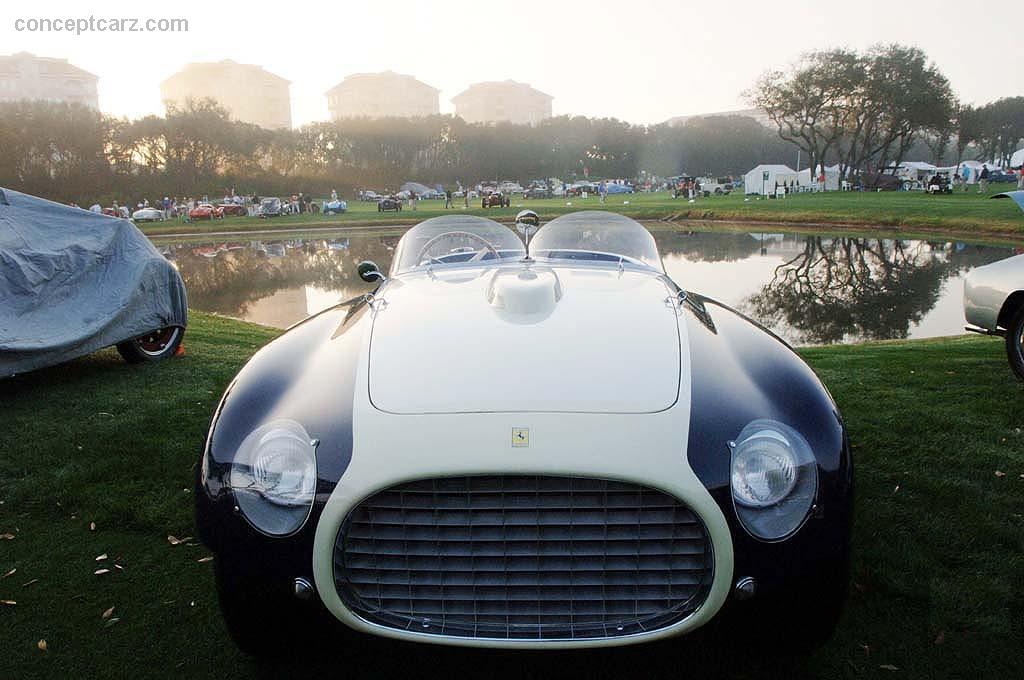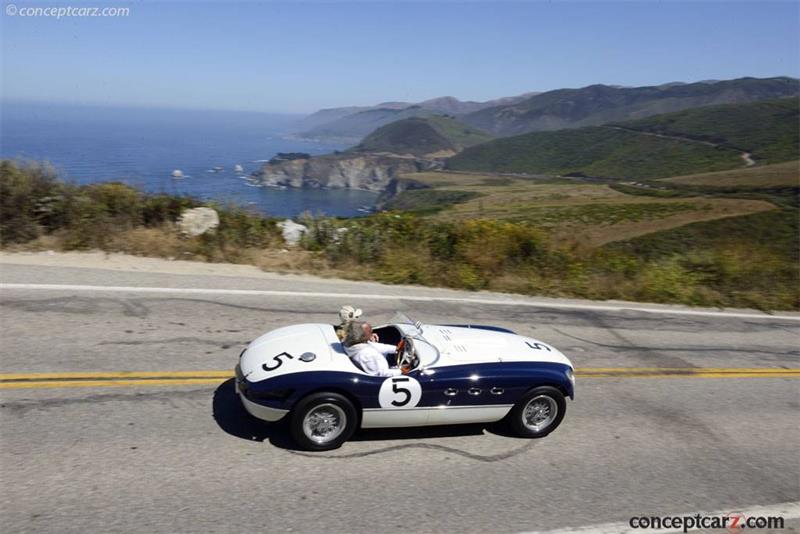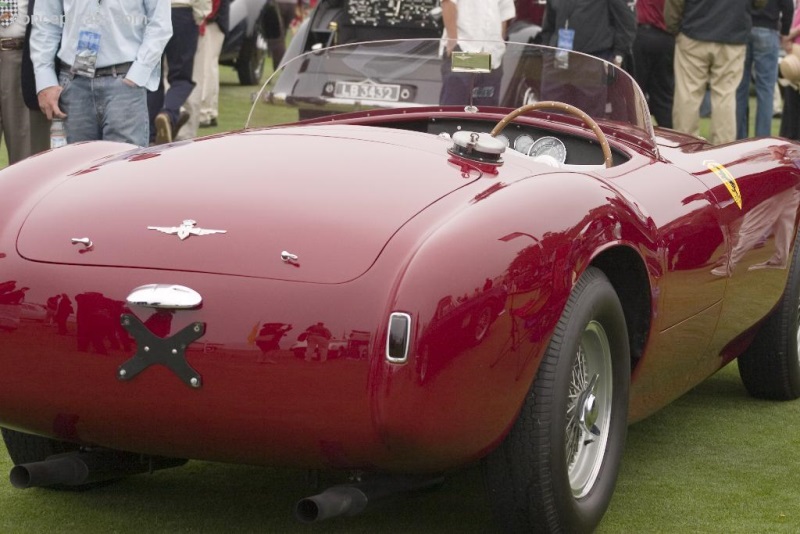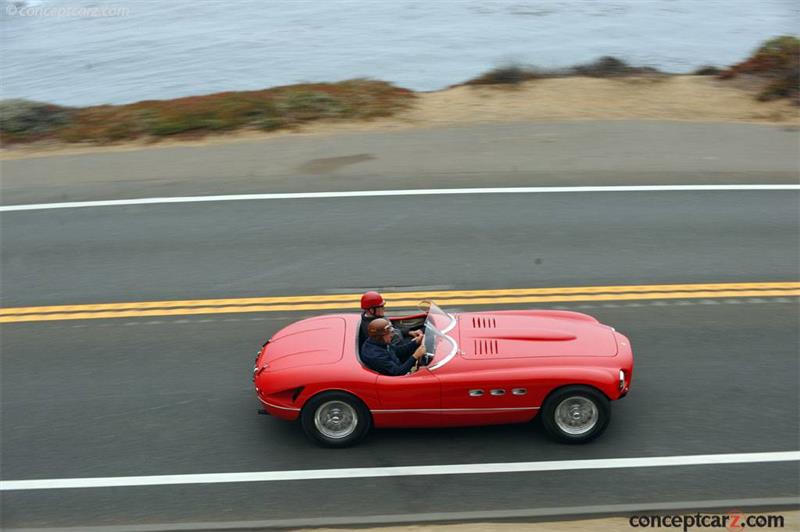The Ferrari 340 and 375 MM were produced in 1953. The engine was an Aurelio Lampredi designed, naturally aspirated, 4.5 liter V12. The cylinder block and heads were cast from light alloy, a metal that was strong but lightweight. 
Spyder by Vignale
Chassis #: 0324 AM
View info and historyThe Lampredi engine, producing 375 horsepower, was first fitted into a 375 F1 and prepared for the 1951 Formula One season. The engines produced by Alfa Romeo were far superior, producing more horsepower and ultimately winning Alfa Romeo the championship. The Lampredi, though underpowered, was a strong contender due to its lightweight and fuel efficiency. Rule changes in 1952 left the Lampredi engine obsolete for Grand Prix racing. This was the end for these engines in Grand Prix racing, but the start of their road-going career. Ferrari created a limited number of vehicles powered by the Lampredi engine, dubbed the 340 and 375 MMs. The first of these vehicles were outfitted with the Tipo 102 engine configuration, the same that had been used in the Grand Prix cars. These were powerful but fairly unreliable. To correct this issue, the bore and stroke were changed slightly, the result was the Tipo 108.Pinin Farina was tasked with creating the coachwork for 26 of the 375 MMs, the most common configurations were the Berlinetta and Spyder. Most of the 340 and 375 MM vehicles were actively raced in the 1950's by their owners.
by Daniel Vaughan | Sep 2019

Spyder by Vignale
Chassis #: 0324 AM
View info and history
by Daniel Vaughan | Sep 2019
Related Reading : Ferrari 340 MM History
Ferrari is the most successful constructor in Formula Ones history, but it all started rather humbly. Despite being an elite, high-profile automaker and racing team, Ferrari performed rather unobtrusively in Formula Ones first season. Success rarely comes overnight, but the waiting period is dramatically shortened when you have already designed a dominant product in which to take and build off.....
Continue Reading >>
Continue Reading >>
Related Reading : Ferrari Type 340 History
It was in 1948 when the newly formed Italian automobile company named Ferrari began selling a promising sports car named the 166. The two-seater sports car featured a 12-cylinder engine mounted in the front and supplying over 100 horsepower to the rear wheels. The engine was just under two-liters in size and had a unitary displacement of 166 cc, thus, the evolution of the model name. Production would....
Continue Reading >>
Continue Reading >>
Similar Automakers
Similarly Sized Vehicles
from 1953
1953 Ferrari 340 MM Vehicle Profiles
Recent Vehicle Additions
Related Automotive News

Landmark Ferraris trace Maranello's race-to-road lineage at Salon Privé
Salon Privé Concours Ferraris of the 50s and 60s class is set to showcase Maranellos remarkable progress from a purely competition-focused manufacturer to one now renowned for building some of the greatest road-going sports cars in the world.
S...

Gooding & Company Releases Entire Catalogue for Upcoming London Sale, Led by a 1953 Ferrari 166 MM/53 Spider Offered from Long-Term Ownership
The London Auction at Hampton Court Palace will present an unrestored Ferrari 166 MM53 Spider and Ferrari 250 Europa, as well as a desirable Fiat 8V Berlinetta and right-hand-drive Aston Martin DB5 Convertible.
Gooding %26 Company, the international...
RRDC VOTES IN 26 NEW MEMBERS FOR 2015
HILLIARD, Ohio (Oct. 23, 2015) - Twenty-six race-car drivers and motorsports professionals have been voted into the Road Racing Drivers Club in 2015. The group includes 11 Regular Members from the open-wheel and sports-car racing ranks, 10 Associate...
RM SOTHEBY'S TO OFFER THE EX-FANGIO, EX-WORKS FERRARI 290 MM IN NEW YORK CITY...
RM SOTHEBYS TO OFFER THE EX-FANGIO, EX-WORKS FERRARI 290 MM IN NEW YORK CITY ONE OF THE WORLDS MOST HISTORIC AND VALUABLE SPORTS RACING CARS
RM Sothebys secures ex-works 1956 Ferrari 290 MM by Scaglietti, chassis 0626, for its Driven...

1959 German Grand Prix: Briton-Italian Dominance Amidst the Darkness
In the pages of Formula One history, the weekend of the 1959 German Grand Prix is usually remembered for a couple of incidents. One of those would see a providential escape. The other, unfortunately, would end in tragedy. Most unfortunate is the fact...































